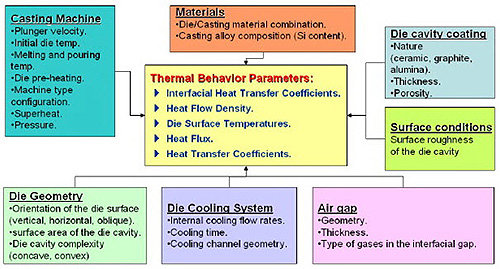Die Casting of Aluminum Alloys: Part One
Abstract
Aluminum castings are used for many industrial applications, for example in the automotive industry, applications includes wheels, cylinder blocks and heads, pistons, brake cylinders, and suspension arms. The substitution of aluminum cast components for ferrous castings in the automotive sector is predicted to continue to grow as automakers continue to seek opportunities to reduce vehicular weight.
Die casting is a manufacturing process in which molten metal is injected, under considerable pressure, into a hardened steel die or also called die casting mold. Dies are often water-cooled. The die is then opened, and the die casting parts are ejected; many times there are thousands of die casting parts each day and sometimes only a few hundred of them. Once the die casting tooling is paid for, die casting parts are a very inexpensive aluminum part manufacturing process.
High pressure die casting is the most widely used, representing about 50% of all light alloys casting production. Low pressure die casting currently accounts for about 20% of production and its use is increasing. Gravity die casting accounts for the rest, with the exception of a small but growing contribution from the recently introduced vacuum die casting and squeeze casting process.
Die casting alloys are normally non-ferrous and there is a large number available with a wide range of physical and mechanical properties covering almost every conceivable application a designer might require. Aluminum and zinc alloys are the most widely used, followed by magnesium, zinc-aluminum (ZA) alloys, copper, tin and lead.
Zinc, lead and tin based alloys are classified as low melting point metals because they turn melt at less than 725°F (385°C). Zinc-aluminum (ZA) alloys have a slightly higher melting range of 800°F to 900°F (426°C to 482°C). Aluminum and magnesium alloys are considered to be moderate melting point alloys, being cast in the 1150°F to 1300°F (621°C to 704°C) range. Copper alloys are considered to be high melting point alloys, over 1650°F (899°C).
Low melting point alloys are cast in hot chamber machines. Intermediate and high melting point alloys are cast in cold chamber machines.
The increasing number of applications and of products is the best proof of the success of aluminum alloys foundry, which is probably one of the most dynamic fields of manufacturing and engineering. The well-known advantages associated to the use of aluminum alloys, such as light weight, good mechanical behavior, good corrosion resistance etc, constitute the driving force for the introduction, on one hand, of new applications and designs and, on the other hand, for the development of new processing solutions. Various processes are now competing to achieve both economically and technologically advantageous production of aluminum alloys castings.
Aluminum castings are used for many industrial applications, for example in the automotive industry, applications includes wheels, cylinder blocks and heads, pistons, brake cylinders, and suspension arms. The substitution of aluminum cast components for ferrous castings in the automotive sector is predicted to continue to grow as automakers continue to seek opportunities to reduce vehicular weight.
The automotive manufacturing usage of aluminum alloy die casting continues to challenge metallurgists and production engineers, as greater emphasis is placed on product quality and production cost. At present, one of the main limits to a wide use of aluminum alloys for automotive applications is a lack of complete understanding of their thermal behavior and of the relationships to micro structural features.
Approximately half of all castings worldwide made of aluminum alloys are used for a wide range of automotive parts and other consumer goods. The machine part design influences the microstructure of the alloy, conditioning the cooling rate during solidification and, of consequence, may have important effects on the part performances.
The structural integrity of shaped castings is closely related to their temperature/time evolution during solidification. A number of analytical and numerical models were developed in the last two decades to treat heat transfer during solidification. The use of casting solidification simulation can do much to increase knowledge of the process; however, some uncertainties must be eliminated before such simulations can be accepted as fully realistic descriptions of the process in all situations.
The heat transfer at the casting–die interface is one of these uncertainties. The way the heat flows across the casting and die surface directly affects the evolution of solidification. The heat transfer coefficient is a critical parameter in solidification modeling. Figure 1 shows a summary of the influential parameters on thermal behavior in die casting process.

Figure 1: Influential parameters on thermal behavior in die casting process.
立即查看铸造材料的精确性能!
Total Materia Horizon 包含数万种铸造材料的性能数据:化学成分、机械和物理性能、非线性性能等。

申请 Total Materia Horizon免费试用帐户,加入来自全球 120 多个国家超过 500,000 名用户的大家庭。